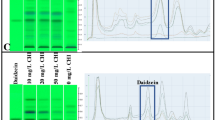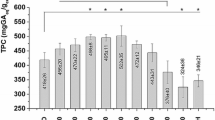Abstract
Antioxidant polyphenols nepetoidin A and B are widely spread in Lamiaceae family yet often remain undetected due to their purported instability and poor extractability with polar solvents typically used for phenolics extraction. Coextraction of nepetoidins may confer additional, or enhance existing, bioactivities of polyphenol extracts. This study includes a detailed analysis of nepetoidin extractability from sweet basil (Ocimum basilicum L.) leaves, and a survey of their occurrence in basil tissue cultures and peltate trichomes. Coextraction of nepetoidins with the major polyphenol rosmarinic acid was possible with solvent mixtures, yet substantially less efficient than that with the respective preferred solvents. Nepetoidin, but not rosmarinic acid levels in extracts from dried leaves were dramatically reduced. However, this was not due to degradation suggested by earlier reports, but to reduced extractability, which could be restored by wetting the tissue with water prior to addition of nonpolar solvent. Nepetoidins were found to accumulate at high levels in basil callus and suspension cultures. Correlation analysis revealed three novel compounds that are coextracted with nepetoidins and are proposed to represent nepetoidin dimers. Candidate signals for nepetoidin and rosmarinic acid glycosides were also detected in dedifferentiated basil cells. By contrast, nepetoidins were not enriched in basil peltate trichomes. This study establishes optimized recovery procedure for nepetoidins, reports their production by dedifferentiated basil cells, and illustrates how sample preparation methodology affects the phytochemical findings.
Key message
This study reports an improved method for the recovery of polyphenolic nepetoidins from fresh and dry plant tissue and demonstrates their high abundance in dedifferentiated Ocimum basilicum cells.








Similar content being viewed by others
Data availability
Processed data from Progenesis QI are available from the authors upon request.
Abbreviations
- RA:
-
Rosmarinic acid
- NA:
-
Nepetoidin A
- NB:
-
Nepetoidin B
References
Arihara S, Rueedi P, Eugster CH (1975) Dopaldehyde isolated for the first time from a plant in the form of its Z-enol E-caffeic acid ester Helv. Chim Acta 58(2):447–453. https://doi.org/10.1002/hlca.19750580214
Bais HP, Walker TS, Schweizer HP, Vivanco JA (2002) Root specific elicitation and antimicrobial activity of rosmarinic acid in hairy root cultures of Ocimum basilicum. Plant Physiol Biochem 40(11):983–995. https://doi.org/10.1016/s0981-9428(02)01460-2
Banthorpe DV, Bilyard HJ, Brown GD (1989) Enol esters of caffeic acid in several genera of the Labiatae. Phytochemistry 28(8):2109–2113. https://doi.org/10.1016/s0031-9422(00)97929-9
Berim A, Gang DR (2018) Production of methoxylated flavonoids in yeast using ring A hydroxylases and flavonoid O-methyltransferases from sweet basil. Appl Microbiol Biotechnol 102(13):5585–5598. https://doi.org/10.1007/s00253-018-9043-0
Berim A, Hyatt DC, Gang DR (2012) A set of regioselective O-methyltransferases gives rise to the complex pattern of methoxylated flavones in sweet basil. Plant Physiol 160(2):1052–1069. https://doi.org/10.1104/pp.112.204164
Berim A, Kim M-J, Gang DR (2015) Identification of a unique 2-oxoglutarate-dependent flavone 7-O-demethylase completes the elucidation of the lipophilic flavone network in basil. Plant Cell Physiol 56(1):126–136. https://doi.org/10.1093/pcp/pcu152
Cao H, Hogger P, Arroo R, Xiao JB (2020) Flavonols with a catechol or pyrogallol substitution pattern on ring B readily form stable dimers in phosphate buffered saline at four degrees celsius. Food Chem. https://doi.org/10.1016/j.foodchem.2019.125902
Chong J, Soufan O, Li C, Caraus I, Li SZ, Bourque G, Wishart DS, Xia JG (2018) MetaboAnalyst 4.0: towards more transparent and integrative metabolomics analysis. Nucleic Acids Res. 46(1):W486–W494. https://doi.org/10.1093/nar/gky310
Cory H, Passarelli S, Szeto J, Tamez M, Mattei J (2018) The role of polyphenols in human health and food systems: a mini-review. Front Nutr. https://doi.org/10.3389/fnut.2018.00087
El-Seedi HR, El-Said AMA, Khalifa SAM, Goransson U, Bohlin L, Borg-Karlson A-K, Verpoorte R (2012) Biosynthesis, natural sources, dietary intake, pharmacokinetic properties, and biological activities of hydroxycinnamic acids. J Agric Food Chem 60(44):10877–10895. https://doi.org/10.1021/jf301807g
Fraga BM, Gonzalez-Coloma A, Alegre-Gomez S, Lopez-Rodriguez M, Amador LJ, Diaz CE (2017) Bioactive constituents from transformed root cultures of Nepeta teydea. Phytochemistry 133:59–68. https://doi.org/10.1016/j.phytochem.2016.10.008
Grayer RJ, Bryan SE, Veitch NC, Goldstone FJ, Paton A, Wollenweber E (1996) External flavones in sweet basil, Ocimum basilicum, and related taxa. Phytochemistry 43(5):1041–1047. https://doi.org/10.1016/s0031-9422(96)00430-x
Grayer RJ, Eckert MR, Veitch NC, Kite GC, Marin PD, Kokubun T, Simmonds MSJ, Paton AJ (2003) The chemotaxonomic significance of two bioactive caffeic acid esters, nepetoidins A and B, in the Lamiaceae. Phytochemistry 64(2):519–528. https://doi.org/10.1016/s0031-9422(03)00192-4
Hakkim FL, Shankar CG, Girua S (2007) Chemical composition and antioxidant property of holy basil (Ocimum sanctum L.) leaves, stems, and inflorescence and their in vitro callus cultures. J. Agric. Food Chem. 55(22):9109–9117. https://doi.org/10.1021/jf071509h
Karabourniotis G, Liakopoulos G (2005) Phenolic compounds in plant cuticles: physiological and ecological aspects. Adv Plant Physiol 8:33–47
Kintzios S, Makri O, Panagiotopoulos E, Scapeti M (2003) In vitro rosmarinic acid accumulation in sweet basil (Ocimum basilicum L.). Biotechnol Lett 25(5):405–408. https://doi.org/10.1023/a:1022402515263
Kwee EM, Niemeyer ED (2011) Variations in phenolic composition and antioxidant properties among 15 basil (Ocimum basilicum L.) cultivars. Food Chem. 128(4):1044–1050. https://doi.org/10.1016/j.foodchem.2011.04.011
Lewandowska U, Gorlach S, Owczarek K, Hrabec E, Szewczyk K (2014) Synergistic interactions between anticancer chemotherapeutics and phenolic compounds and anticancer synergy between polyphenols. Postepy Hig Med Dosw 68:528–540. https://doi.org/10.5604/17322693.1102278
Nadeem M, Abbasi BH, Younas M, Ahmad W, Zahir A, Hano C (2019) LED-enhanced biosynthesis of biologically active ingredients in callus cultures of Ocimum basilicum. J Photochem Photobiol B 190:172–178. https://doi.org/10.1016/j.jphotobiol.2018.09.011
Nakanishi T, Nishi M, Inada A, Obata H, Tanabe N, Abe S, Wakashiro M (1990) Two new potent inhibitors of xanthine oxidase from leaves of Perilla frutescens Britton vs. acuta Kudo. Chem. Pharm. Bull. 38(6):1772–1774
Nazir M, Tungmunnithum D, Bose S, Drouet S, Garros L, Giglioli-Guivarc’h N, Abbasi BH, Hano C (2019) Differential production of phenylpropanoid metabolites in callus cultures of Ocimum basilicum L. with distinct in vitro antioxidant activities and in vivo protective effects against UV stress. J. Agric. Food Chem. 67(7):1847–1859. https://doi.org/10.1021/acs.jafc.8b05647
Nazir M, Ullah MA, Younas M, Siddiquah A, Shah M, Giglioli-Guivarc’h N, Hano C, Abbasi BH (2020) Light-mediated biosynthesis of phenylpropanoid metabolites and antioxidant potential in callus cultures of purple basil (Ocimum basilicum L. var purpurascens). Plant Cell Tissue Organ Cult 142(1):107–120. https://doi.org/10.1007/s11240-020-01844-z
Ngo YL, Lau CH, Chua LS (2018) Review on rosmarinic acid extraction, fractionation and its anti-diabetic potential. Food Chem Toxicol 121:687–700. https://doi.org/10.1016/j.fct.2018.09.064
Nunes S, Madureira AR, Campos D, Sarmento B, Gomes AM, Pintado M, Reis F (2017) Therapeutic and nutraceutical potential of rosmarinic acid-Cytoprotective properties and pharmacokinetic profile. Crit Rev Food Sci Nutr 57(9):1799–1806. https://doi.org/10.1080/10408398.2015.1006768
Pandey AK, Singh P, Tripathi NN (2014) Chemistry and bioactivities of essential oils of some Ocimum species: an overview. Asian Pac J Trop Biomed 4(9):682–694
Pandey P, Singh S, Banerjee S (2019) Ocimum basilicum suspension culture as resource for bioactive triterpenoids: yield enrichment by elicitation and bioreactor cultivation. Plant Cell Tissue Organ Cult 137(1):65–75. https://doi.org/10.1007/s11240-018-01552-9
Papazian S, Parrot D, Buryskova B, Weinberger F, Tasdemir D (2019) Surface chemical defence of the eelgrass Zostera marina against microbial foulers. Sci. Rep. https://doi.org/10.1038/s41598-019-39212-3
Petersen M (2013) Rosmarinic acid: new aspects. Phytochem Rev 12(1):207–227. https://doi.org/10.1007/s11101-013-9282-8
Phippen WB, Simon JE (2000) Shoot regeneration of young leaf explants from basil (Ocimum basilicum L.). In Vitro Cell. Dev. Biol. Plant 36(4):250–254
Scheepens A, Tan K, Paxton JW (2010) Improving the oral bioavailability of beneficial polyphenols through designed synergies. Genes Nutr 5(1):75–87. https://doi.org/10.1007/s12263-009-0148-z
Schilmiller AL, Last RL, Pichersky E (2008) Harnessing plant trichome biochemistry for the production of useful compounds. Plant J 54(4):702–711. https://doi.org/10.1111/j.1365-313X.2008.03432.x
Snyder LR (1974) Classification of the solvent properties of common liquids. J Chromatogr 92:223–230
Snyder LR (1978) Classification of the solvent properties of common liquids. J Chromatogr Sci 16(6):223–234
Sonam KS, Guleria S (2017) Synergistic antioxidant activity of natural products. Ann Pharmacol Pharm 2(8):1086
Srivastava S, Conlan XA, Adholeya A, Cahill DM (2016) Elite hairy roots of Ocimum basilicum as a new source of rosmarinic acid and antioxidants. Plant Cell Tissue Organ Cult 126(1):19–32. https://doi.org/10.1007/s11240-016-0973-x
Strazzer P, Guzzo F, Levi M (2011) Correlated accumulation of anthocyanins and rosmarinic acid in mechanically stressed red cell suspensions of basil (Ocimum basilicum). J Plant Physiol 168(3):288–293. https://doi.org/10.1016/j.jplph.2010.07.020
Timokhin V, Regner M, Tsuji Y, Grabber J, Ralph J (2018) Synthesis of nepetoidin B. Synlett 29(9):1229–1231. https://doi.org/10.1055/s-0036-1591556
Trivellini A, Lucchesini M, Maggini R, Mosadegh H, Villamarin TSS, Vernieri P, Mensuali-Sodi A, Pardossi A (2016) Lamiaceae phenols as multifaceted compounds: bioactivity, industrial prospects and role of "positive-stress". Ind Crops Prod 83:241–254. https://doi.org/10.1016/j.indcrop.2015.12.039
Tsai SF, Lee SS (2014) Neolignans as xanthine oxidase inhibitors from Hyptis rhomboides. Phytochemistry 101:121–127. https://doi.org/10.1016/j.phytochem.2014.01.016
Williamson G (2017) The role of polyphenols in modern nutrition. Nutr Bull 42(3):226–235. https://doi.org/10.1111/nbu.12278
Wu X, Gao H, Sun W, Yu J, Hu H, Xu Q, Chen X (2017) Nepetoidin B, a natural product, inhibits LPS-stimulated nitric oxide production via modulation of iNOS mediated by NF-kappa B/MKP-5 pathways. Phytother Res 31(7):1072–1077. https://doi.org/10.1002/ptr.5828
Zhang Y, Lin N, Su S, Shen G, Chen Y, Yang C, Li W, Shen H, Huang Y, Chen H et al (2014) Freeze drying reduces the extractability of organochlorine pesticides in fish muscle tissue by microwave-assisted method. Environ Pollut 191:250–252. https://doi.org/10.1016/j.envpol.2014.04.018
Acknowledgements
We thank Julie Thayer and the greenhouse staff of the Institute of Biological Chemistry, Washington State University (Pullman, WA) for growing the SW sweet basil.
Funding
This study was partially funded by the US Department of Energy – Biological and Environmental Research program (Grant No. DE–SC0001728 to D.R.G.), and by the USDA National Institute of Food and Agriculture, Hatch project 227700.
Author information
Authors and Affiliations
Corresponding authors
Ethics declarations
Conflicts of interest
The authors declare that they have no conflicts of interest.
Additional information
Communicated by Christophe Hano.
Publisher's Note
Springer Nature remains neutral with regard to jurisdictional claims in published maps and institutional affiliations.
Electronic supplementary material
Below is the link to the electronic supplementary material.
Rights and permissions
About this article
Cite this article
Berim, A., Gang, D.R. Extractability, stability, and accumulation of nepetoidins in Ocimum basilicum L. leaves and cell cultures. Plant Cell Tiss Organ Cult 143, 75–85 (2020). https://doi.org/10.1007/s11240-020-01897-0
Received:
Accepted:
Published:
Issue Date:
DOI: https://doi.org/10.1007/s11240-020-01897-0




